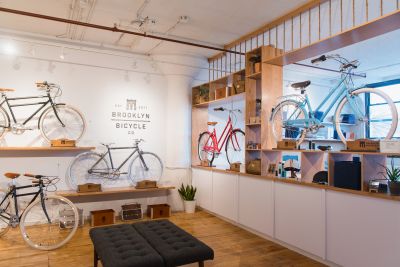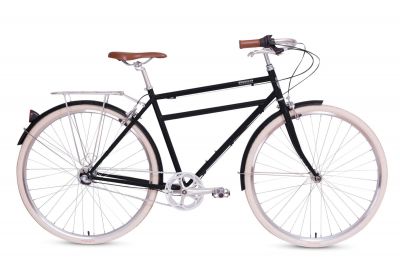BROOKLYN, N.Y. (BRAIN) — BRAIN's recent "Pandemic Check-in" Q&A's have featured executives with large IBD suppliers in Wisconsin, California, and Minnesota. Today we check in with a smaller supplier who is based in one of the pandemic's hot spots and who is experiencing a major sales boom, with sales up 600% so far this year.
Brooklyn Bicycle Co. makes stylish, affordable urban bikes that are sold via IBD showrooms as well as via the company's website — with all bike sales fulfilled by the brand's IBD partners. Founder and president Ryan Zagata said urban dwellers are buying up the bikes this year for commuting, transportation and fitness, and he expects solid sales to continue after the pandemic.
Before we talk too much about Brooklyn Bicycle Company, tell me what it’s like operating a business in the epicenter of the virus.
If you’re not in the New York metropolitan area and you’re watching TV, you could very well think that there are bodies in the streets and mass burials in our parks but that’s clearly not the case. For better or worse much of the impact has been localized to specific communities within the city. I know a handful of people who have gotten sick but by and large they’ve recovered. While I haven’t personally seen a lot of COVID-related illness, I am very mindful that it is very much here in the city. I find there to be an element of sadness here in New York with the realization that the city that people moved here for, and that they have learned to love and appreciate, may never be the same again. The 23-year-old kids who moved here for the singles crowd, for the nightlife, for the outdoors, the high-paying jobs, it may not exist after this. So there is a distinct awareness that a bounce-back might not lead to the same New York that we all know. And yet from the same perspective, many people are looking for where there is an opportunity to make New York a better place, and that’s what makes me most proud about this city.
For the business, the entire team has been working remotely except for myself. At the very beginning of this, we looked at our operations from every angle to understand where we could potentially be at risk and beyond that, understanding what was within our control. That led to us staging our showroom as a warehouse, bringing a lot of bikes here and setting up shipping stations. We also implemented free local curbside delivery to accommodate customers who were not keen on leaving their homes. We relaxed our return policy for customers local here in New York and quickly set up virtual showroom tours where we walk people through the models, talk sizing and use cases. We’ve seen a tremendous conversion rate there.
"Many people are looking for where there is an opportunity to make New York a better place, and that’s what makes me most proud about this city."
As a small company we’ve had an opportunity to be nimble to quickly adapt and I feel like everything we have done since I launched this company in 2011 has prepared us for this moment. We are relying heavily on our 450 IBD partners across the United States and Canada. That’s who is building the bikes that are sold online and even here in New York we rely on our local partners, so the infrastructure we have built over the years is really paying massive dividends right now and we are putting a lot of money in the pockets of our local retail partners.
Through this, it has become clear that that there will be a reluctance to take public transportation across the country and that creates opportunity for us and for cities. People are staying home and again, while everyone wants this city to come back to life, they are also aware that it is not going to be the same.

It sounds like you have a decent amount of retail sales through your Brooklyn showroom.
We operate as a true showroom and nobody ever leaves the showroom with a bicycle except once a year we’ll do a sample sale. Probably the biggest benefactor of this is our neighborhood shop, Silk Road Cycles, which is all of two and half blocks from here. People come in, test ride a bike and if they want to ride off that day, we tell them they can roll over to the shop a few blocks from here and probably take it home. So even here in our backyard, all of the bikes that are sold are still fulfilled by our partners.
We have never shipped bikes to people’s porches, that was our commitment when I started the brand. We’ve always fulfilled everything through our IBDs. One of the things I feel good about is that we’re able to put a lot of money in the pockets of some of these retail partners that took a chance on us six or seven years ago. We are sending a lot of online sales to these stores. These are customers that may have not come into the store otherwise, and they are coming in to pick up their bike and they are buying a lock and a helmet and a bell, high-margin accessories.
We vet our partners pretty well, so most of these people are getting treated really well, so it feels good to see the numbers we are putting up but it feels equally as good to know that these shops are doing well.
What percentage of your sales are wholesale versus e-commerce?
If I go back about four years our business was about 85% wholesale (sales to shops) and 15% retail (e-commerce fulfilled by shops). Now if you look at year-to-date, we are up about 600% .. and year to date we are about 80% e-commerce and 20% wholesale. A small part of that is because wholesale has slipped a little bit with shops closing, but the bigger part of it is that our e-commerce has really become the crown jewel of the business. We’re just pumping a lot money and energy into it from a marketing perspective, driving traffic there, which in turn drives traffic to our dealer partners and it feels really good.
Sales are booming for you, it seems like Brooklyn bikes fill the need for affordable transportation bikes during the pandemic.
What I hear from shops is, if it’s under $1,000, or even better, under five or six hundred or lower, it’s sold within five minutes of being assembled and put on the floor. Almost all of our bikes are at the $500 price point. We have a range of around town bikes, but our top sellers are our chromoly hybrids. We sell the daylights out of those. A lot of people reaching out just want something they can ride around and get some sanity, but a lot of it has been new commuters.
I feel like everything we have done since I launched this company in 2011 has prepared us for this moment.
Are the commuters mostly in New York?
No, that’s all over the country and Canada. New York is our backyard so we do a lot here, but probably less than 30% of our business is local. We do very well in DC, Boston, San Fran, Seattle, Los Angeles, Houston and Chicago, virtually every major metro. We don’t design bikes for rural Iowa. We focus on urban mobility, so we aren’t selling a lot of bikes in suburban areas. We sell in urban areas, which, like I think Rich Tauer from QBP alluded to the other day, is one of the three phenomenons we’re seeing right now: the transportation rider, and that’s who we focus on.
How’s your inventory holding up?
Our inventory now is virtually non-existent. We have some cruiser bikes left, but a couple days ago people were buying the wrong sized bike, now they’ll buy anything with two wheels and pedals. They don’t care what color it is. So inventory is very depleted — We’ve gone through a year’s worth of inventory in the last 45 days. … So that is a concern. From a purely monetary perspective our business is: we send money to our factories, we get bikes, we turn those bikes into cash and we start that all over. So it’s not disappointing to turn those bikes into cash. What is disappointing is that we are in an unprecedented time in the industry especially in our niche, and we are out of inventory. But we are about 30 days out from seeing inventory. So I think we are going to see about a two-week lull and then we’ll roll right into it and keep on going. Here in New York it doesn’t look like the city is going to be opening up before mid to late June, so I think we’ll be rolling in inventory before then.
"If it’s under $1,000, or even better, under five or six hundred or lower, it’s sold within five minutes of being assembled and put on the floor."
We’ve also seen some opportunities for delivery improvement from Shimano and other suppliers. I’ve spoken with all of our suppliers and a lot of the bigger (bike) brands are pausing or holding their higher-end bikes, which allows us to see some improvement in delivery times, which we’ve taken advantage of.
We also really diversified our business about a year and a half ago. A big part of our business now is selling fleet bikes. We do a lot of bikes for corporations and hotels. Certainly those two have gone silent but we’ve also partnered with New Belgium (Brewery) and we are going ahead with our third year of bikes for them, which not only is great because there’s no inventory risk, but it’s also just one of the best brands you could imagine to work with. They are such fun people and they have a lot of great ideas, and, uh, a lot of their beer shows up in our showroom.
"A couple days ago people were buying the wrong sized bike, now they’ll buy anything with two wheels and pedals."
We also applied for a tariff exclusion, which we got last week, which was a hard-fought win for us. The 301 tariffs are just not the right thing for the industry at this time. I admire the administration for their efforts against China, in trying to make China be more fair. I don’t think anyone will ever argue that China cheats in some ways. The only real upside to the tariffs for us is it forced us to look at our supply chain and it really made us a lot more nimble and that's paying dividends now. We really have the ability now to manufacture either in China or Taiwan pretty much at a moment’s notice, and that’s worked out very favorably for us. Bikes we had made in Taiwan we are now going to assemble in China and take advantage of the exclusion. So the 301 forced us to go through an exercise that we should have done many years ago.
Looking beyond the inventory you are getting in in the next 30 days, how bullish are you on the rest of the year?
I guess entrepreneurs are eternally optimistic or we’d have never started a business in the first place. But I will say, there are some minor things that concerns me, but I’ve talked to so many customers, the end-users, and I try to understand why are they buying a bike now, why didn’t they buy it last year or two years ago. The infrastructure in New York and Chicago and some of these cities has improved substantially and that makes cyclists feel safer. And yet we hadn’t really seen that corresponding jump in bike commuting. But the conversations I’m having now make me incredibly optimistic. Almost every caller is a new cyclist. And almost every caller is asking for advice on bike commuting. And there are some people looking for fitness. All your gyms are shut down. And if you are all cooped up you can get out and get somewhere, especially in cities where people don’t have cars. Bicycles really expand the radius of your community.
I’ve never felt more optimistic. I think a lot of these people are not going to go back to the subways.
This kind of buyer isn't replacing their bike every season. Can the market continue to produce these first-time bike commuters to sustain the growth?
The kind of growth we are seeing in the short term, no, that's not sustainable. But I do think there are new people coming up every year that are leaving universities and that are moving to metropolitan areas. So there's an opportunity there. And New York is a city of millions and millions of people who take public transportation. We only need a small fraction of those people to take up cycling to sustain growth in commuting. 
And cities now aren’t seeing very much vehicular traffic so they have a tremendous opportunity to capture these new cyclists and retain them as full-time commuters. I’d love nothing more than to see New York City shut down one of its major thoroughfares and make it a permanent north-south (bike) commuter street. They’ve closed a few streets now. I think now is the time, now that bike commuters have started. I’d love to see these cities make the necessary infrastructure investments to help keep these new commuters feeling safe.
There’s been a lot of discussion about that here in New York, but I think right now the city is focused on trying to keep people alive rather than infrastructure improvements.
What are the chances that cities are going to do this? Otherwise, when the traffic returns and people feel unsafe, it might all end.
Well here in New York, Mayor Di Blasio recently launched a committee to work on bringing New York back to life, and one of his stated goals was to make New York a better place and more fair for all New Yorkers. I think cycling is the most economical transportation available where people can feel safe. $500 for a new bike is not even 6 months of a monthly subway pass. So if you want to talk about fairness and equity and giving people opportunities you would not have otherwise afforded them, bikes are one of the best things out there. To me, if you want to talk fairness, let’s start with how do we get people around the city in a safe and equitable manner. I’d be very surprised if that wasn’t part of the conversation. … It’s great time to be in the bike industry.
Not everyone is doing as well as you and your shops. There are layoffs at some suppliers, and public companies are reporting significant sales declines. Do you think that pain is all at the high end?
That’s one of the things. We’re hearing from shops we haven’t heard from in 2-3 years. Out of nowhere they are reaching out to us and ordering two or three dozen bikes at a clip. And then I talk to them and they say with their other brands, if you want anything over $1,000 you can get anything you want. Speciality bikes — mountain bikes, road bikes — I don’t think anyone is sniffing at those markets right now. I would imagine that part of the market has fallen drastically. And those are big segments of the market that Specialized, Trek, and Giant rely on for their profits. ... I think their business model relies on multiple segments of their portfolios hitting. So even if they are having a bonanza at the lower end of the segment, they have a lot of cash tied up at the higher end. It’s great that you are having inventory turns at the low end, but if your high-end bikes are sitting on shelves, that’s tying up capital. That’s where for a brand like us, it's advantageous to be in segment of the market that is doing well. Our cash flow is better than it's ever been. We don’t have money tied up in bikes in warehouses. (So for those other companies), right now because some segments are performing incredibly poorly, that’s going to cause them some problems from a cash perspective.




